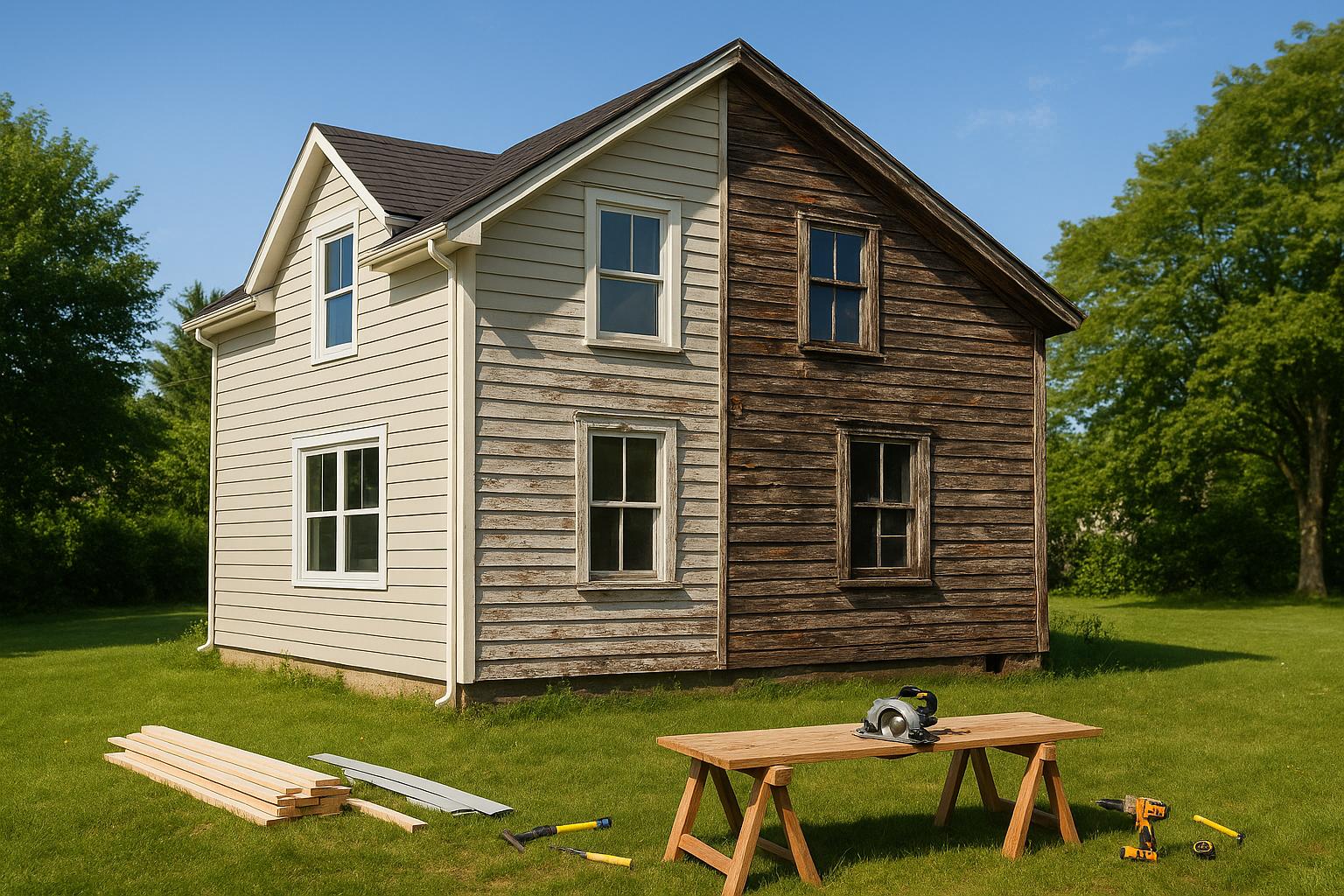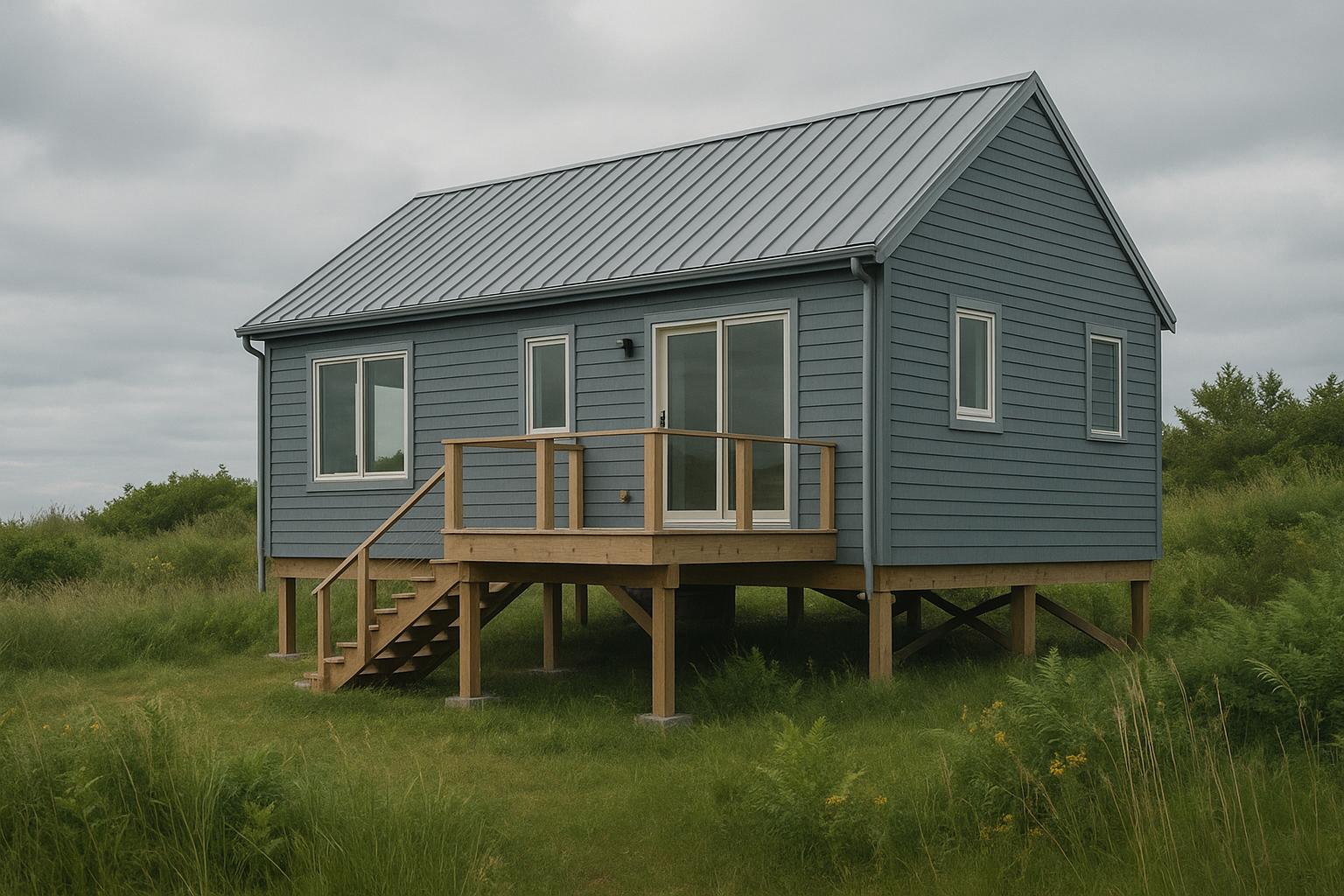Building a coastal home in Nova Scotia is about combining breathtaking ocean views with smart design to handle salt, storms, and flooding. Here's what you need to know to create a durable, stylish, and safe oceanfront property:
- Key Challenges: Salt air causes corrosion, storms bring strong winds and heavy rain, and flooding is a serious risk.
- Smart Solutions: Use materials like stainless steel, fibre-cement siding, and marine-grade finishes. Protect your home with hurricane-rated windows, elevated foundations, and proper drainage.
- Outdoor Living: Position windows for views, use salt-resistant decking, and plant wind-tolerant gardens.
- Maintenance: Regularly clean salt residue, repaint surfaces, and choose hardware designed for coastal conditions.
- Budgeting: Fixed-price builds start at $168/ft², with examples showing strong rental income and property value growth.
Nova Scotia's coastal lifestyle is stunning, but it requires careful planning. Use durable materials, follow local building laws, and partner with experienced builders to protect your investment and enjoy the oceanfront for years to come.
A Guide to Buying a Coastal Home in Nova Scotia
Weather and Climate Risks
Nova Scotia's coastal climate comes with challenges that need careful planning, especially when building oceanfront homes. To create a durable coastal home, it's crucial to address risks like salt damage, storms, and flooding. Here's how you can protect your property.
Salt Exposure Effects
Salt air is tough on coastal properties. It speeds up metal corrosion and wears down materials faster than usual. To combat this, choose materials and finishes designed for this environment, such as:
- Stainless steel hardware
- Corrosion-resistant window frames
- Marine-grade finishes
- Salt-resistant siding
Regular upkeep and smart material choices are essential here. These steps also help prepare your home to handle severe storms.
Storm Protection
Being on the Atlantic coast, Nova Scotia faces Nor’easter storms and occasional hurricanes. These storms bring challenges like:
- Strong winds
- Heavy rainfall
- Storm surges
- Flying debris
To protect your home, consider these design features:
- Hurricane-rated windows and doors
- Reinforced roof structures
- Building orientation to reduce wind impact
- Sheltered outdoor areas
But storm protection is only part of the puzzle - addressing flood risks is just as important.
Flood Prevention
Storm surges and flooding are serious threats for oceanfront homes. The right design decisions can make a big difference:
| Prevention Method | Purpose | Implementation |
|---|---|---|
| Elevated Foundations | Protect against storm surges | Raise living spaces above flood levels |
| Site Grading | Redirect water flow | Create slopes for proper drainage |
| Flood Barriers | Emergency flood protection | Install permanent or temporary barriers |
These measures, especially elevated foundations and well-planned site grading, have proven effective in reducing damage during severe weather.
"Having a guaranteed price was everything for my first project. Helio took me from day-one design through lease-up, all without the hidden costs I dreaded. I couldn't have asked for a smoother introduction to development." - Michael T., New Developer [1]
Building Strong Coastal Homes
Constructing a durable coastal home in Nova Scotia requires materials and techniques that can handle the region's tough maritime environment. Prioritizing sturdy materials, solid foundations, and weather-resistant windows and doors is essential for both safety and style.
Best Materials for Coastal Homes
The right materials can make all the difference in protecting your home against coastal conditions. For exterior cladding, fibre-cement siding and treated eastern white cedar shingles are excellent options that combine strength with a classic coastal look. Here's a breakdown of material recommendations for key structural components:
| Component | Recommended Material | Benefits |
|---|---|---|
| Roofing | Standing seam metal | Long-lasting and resists strong winds |
| Fasteners | Marine-grade stainless steel | Withstands salt air corrosion |
| Decking | Composite materials | Low-maintenance and salt-resistant |
| Railings | Marine-grade aluminum | Corrosion-resistant and easy to maintain |
Foundation Requirements
To protect against flooding and storm surges, elevate your foundation with raised or stilted designs. Reinforced materials and proper drainage systems are critical for added strength and longevity.
Window and Door Standards
Choose windows and doors built to handle high winds and impacts. Features like multiple glazing layers and corrosion-resistant frames are ideal. Fibreglass or steel exterior doors with reinforced locks provide reliable security. These measures not only protect your home but also allow you to fully enjoy ocean views and outdoor spaces without compromising safety.
Ocean Views and Outdoor Spaces
Designing a coastal home involves balancing stunning ocean views with the challenges of a maritime environment. Thoughtful placement of windows, outdoor spaces, and gardens can enhance both the aesthetics and functionality of your home.
Maximizing Views
Position living areas to take full advantage of natural light and ocean views while keeping wind exposure in check. Consider using triple-glazed windows with low-E coatings - they not only frame the scenery beautifully but also block UV rays and improve energy efficiency.
Decks and Patios Built to Last
For outdoor spaces like decks and patios, choose materials that can handle coastal conditions. Marine-grade railings, composite decking, and retractable awnings are excellent options for durability and comfort. Adding windbreaks can make these areas more enjoyable by reducing the impact of strong coastal winds. This setup also helps create a smooth connection between indoor and outdoor living spaces.
Coastal Gardens That Work
When planning a coastal garden, focus on plants that can handle salty air and strong winds. Use salt-tolerant plants in layered arrangements to act as natural windbreaks. Features like rock gardens or raised beds can improve drainage and reduce upkeep. Arrange the plants to stabilize soil and shield them from harsh elements, ensuring your garden complements the overall design of your coastal home.
sbb-itb-16b8a48
Building Permits and Rules
Building your dream home along Nova Scotia's coast requires careful attention to local rules and permits. Getting familiar with these requirements early can make the construction process smoother while ensuring your project meets safety and environmental standards.
Coastal Building Laws
The Nova Scotia Coastal Protection Act sets clear rules for building near the ocean. These include setback requirements and assessments to safeguard coastal ecosystems and protect your property. Building in these areas often requires additional permits beyond the usual approvals. Reaching out to local authorities early in your planning can help you navigate zoning and environmental rules more effectively.
Working with Local Builders
Partnering with local builders can simplify the process. Their expertise in permits, timelines, and budgeting can save time and reduce stress. For instance, a duplex in Colchester was completed in just seven months for $599,000, with a cost of about $165/sq.ft. The property was later appraised at $830,000, offering instant equity [1].
Experienced builders bring several benefits:
- Permit Expertise: They understand local zoning and coastal protection requirements.
- Efficient Timelines: They help ensure permits are approved quickly.
- Budget Management: Fixed-price contracts, starting at $168/sq.ft, help avoid unexpected costs [1].
- Regulatory Knowledge: They ensure your project meets all coastal construction standards.
When choosing a builder, prioritize those who offer full support with permits and have strong connections with local authorities. This can help speed up approvals and ensure your coastal home complies with all regulations.
Home Care by the Ocean
Keeping your coastal home in great shape requires consistent upkeep. Once you've built a sturdy and durable home, regular maintenance is key to preserving its beauty and functionality over time.
Exterior Maintenance
Living by the ocean comes with its own set of challenges, especially for your home's exterior. A regular maintenance routine can help combat the effects of salt and moisture. Here's what to focus on:
- Wash the exterior frequently to remove salt residue.
- Inspect and clean gutters regularly to prevent salt and debris buildup.
- Repaint or reseal surfaces promptly to maintain their protective layers.
Using materials designed for coastal environments can make a big difference. Consider these options:
| Material | Recommendation |
|---|---|
| Paint | Elastomeric coating |
| Sealants | Silicone-based formulations |
| Hardware | 316-grade stainless steel |
| Gutters | Aluminium or vinyl |
These materials are better suited to withstand the harsh coastal elements.
Managing Salt Damage
Salt can be tough on your home, but there are ways to protect against it. Here are some practical methods:
-
Rinse and Clean
- Set up an outdoor rinse station to wash salt off surfaces and fixtures.
- Use salt-neutralizing cleaners on metal areas.
- Clean windows and glass doors with a vinegar-water mixture to remove salt deposits.
-
Choose the Right Materials
- Go for vinyl or aluminium window frames instead of wood, which is prone to salt damage.
- Use composite decking materials that are made to resist salt.
- Opt for powder-coated metal fixtures and marine-grade hardware for outdoor use.
-
Preventive Measures
- Apply rust inhibitors to exposed metal surfaces regularly.
- Install sacrificial anodes on metal components to reduce corrosion.
- Plant salt-tolerant vegetation to act as natural wind barriers and reduce salt spray.
- Use breathable, water-repellent sealants on masonry to prevent moisture damage.
With the right materials and maintenance habits, you can enjoy oceanfront living while keeping your home protected and looking its best.
Next Steps
Once you've taken care of your oceanfront property, it's time to plan the next steps for building a strong and reliable coastal home. If you're dreaming of creating your ideal home along Nova Scotia's coastline, expert advice and careful planning are key to overcoming the unique challenges of coastal construction.
With fixed-price construction starting at $168/ft², you can avoid unexpected costs and protect your investment. This pricing model has been successfully applied to numerous coastal projects [1].
Here are the key phases to focus on when building your maritime home:
| Building Phase | Key Considerations |
|---|---|
| Initial Planning | Site evaluation, zoning review, environmental assessments |
| Design | Durable materials, optimizing views, wind protection |
| Permits | Compliance with the Coastal Protection Act, municipal approval |
| Construction | Weather-resistant methods, quality control, timeline management |
To help you navigate this process, our free 30-page master playbook provides detailed guidance on everything from land evaluation to obtaining final approvals [1]. It's a valuable tool to keep your project aligned with your vision.
Building a coastal home in Nova Scotia requires a solid understanding of the region's specific environmental factors. Work with builders who are experienced in local regulations and oceanfront construction. By prioritizing these steps, you can turn your dream into a secure and inspiring reality.
FAQs
What should I consider when choosing materials for a coastal home in Nova Scotia?
When building a coastal home in Nova Scotia, durability and resistance to harsh weather are key. The salty air, high winds, and storms common along the province’s shoreline can take a toll on materials, so selecting the right ones is essential.
Opt for weather-resistant materials like fibre-cement siding or cedar shingles, which can withstand salt spray and moisture. For exterior fixtures, choose stainless steel or fibreglass to prevent rust, and use corrosion-resistant fasteners to ensure longevity. These choices not only meet Nova Scotia’s unique climate demands but also align with provincial building codes designed for coastal durability.
By prioritizing materials that resist the elements, you’ll ensure your oceanfront home remains beautiful and functional for years to come.
How can I design a coastal home in Nova Scotia that captures stunning ocean views while staying protected from harsh weather?
To design a coastal home that balances breathtaking ocean views with protection from the elements, start by installing hurricane-rated or triple-glazed windows. These not only offer expansive views but also withstand strong winds and reduce salt damage. Opt for tempered glass or UV-resistant coatings to prevent fading and corrosion over time.
Position your home to take full advantage of the view, such as orienting it to capture both sunrises and sunsets if possible. Enhance outdoor spaces with glass railings for unobstructed views and consider adding windbreak landscaping like salt-tolerant grasses or tree lines to shield against prevailing winds. Thoughtful design choices will ensure your home remains both beautiful and durable in Nova Scotia’s coastal climate.
What do I need to know about complying with the Nova Scotia Coastal Protection Act when building an oceanfront home?
When planning to build an oceanfront home in Nova Scotia, it’s essential to understand and comply with the Nova Scotia Coastal Protection Act to ensure your project meets environmental and regulatory standards. This legislation is designed to safeguard coastal ecosystems and reduce risks from erosion, flooding, and storm surges.
To comply, you’ll need to determine if your property falls within a designated coastal protection zone. If it does, you may need to complete assessments, such as environmental impact studies, and adhere to specific setback requirements from the shoreline. Working with a knowledgeable builder familiar with local regulations can simplify the process and ensure your home is both compliant and resilient against coastal challenges.
For detailed guidance, consult Nova Scotia’s provincial resources or speak with a professional experienced in coastal development to navigate permitting and design considerations effectively.
Related Blog Posts
- Building on the Nova Scotia Coast: How to Design and Construct Durable Seaside Home
- Building a Custom Home in Eastern Passage: Coastal Living and Development Tips
- Common Mistakes to Avoid When Building a Home in Nova Scotia
- Green Building in Nova Scotia: Top 10 Energy-Efficient Features for Your Custom Home



